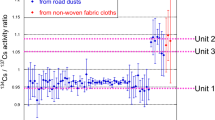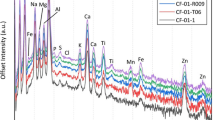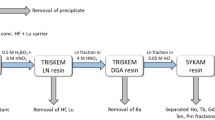Abstract
SINCE the beginning of atom bomb tests, the physical and chemical properties as well as the biological effects of radioactive fall-out particles have been the subject of numerous investigations1–8. Discussions on the mechanism of formation of these particles and on the question of their effects on the human organism after inhalation or ingestion1,2,4, which are highly dependent on their solubility, require a knowledge of their composition1,4,9. Comparison of particle diameters, obtained by electron microscopy, with the content of radioactive nuclides, determined by radiochemical methods and γ-spectrometry, shows that the particles contain more inactive material than is produced by the decay of the radioactive fission products and the induced radioactive elements2,9. In the case of atmospheric explosions, this additional inactive component comes from unfissionable materials used in building the atomic device, and in the case of near-surface explosions also materials from the ground can be involved1.
This is a preview of subscription content, access via your institution
Access options
Subscribe to this journal
Receive 51 print issues and online access
$199.00 per year
only $3.90 per issue
Buy this article
- Purchase on Springer Link
- Instant access to full article PDF
Prices may be subject to local taxes which are calculated during checkout
Similar content being viewed by others
References
Rep. U.N. Sci. Comm. Effect of Atomic Radiation (New York, 1962).
Rajewsky, B., Franke, Th., Groos, E., Heyder, J., Kaul, A., Lippert, W., and Rajewsky, M. F., Atompraxis, 7, 8 (1962).
Kern, W., Nukleonik, 2, 5, S, 203 (1960).
Nat. Acad. Sci.—Nat. Res. Counc., Washington, D.C., Pub. 848 (1961).
Adams, C. E., Farlow, N. H., and Schell, W. R., Geochim. Geophys. Acta, 18, 42 (1960).
U.S. Atomic Energy Comm. and U.S. Air Force Proj. RAND, Proj. Sunshine, U.N. Document A/AC.82/G/R.72.
Martell, E. A., U.S.A.E.C. Rep. AECU-3262 (1956), U.N. Document A/AC.82/G/R.153
Stewart, K., Trans. Farad. Soc., 52, 161 (1956).
Rajewsky, M. F., Nature, 195, 369 (1962).
Neff, H., Vortrag auf der Jahrestagung der Deutschen Gesellschaft für Elektronenmikroskopie, Kiel (1961).
Atompraxis (in preparation).
Kaul, A., and Nay, U. (in preparation).
Author information
Authors and Affiliations
Rights and permissions
About this article
Cite this article
RAJEWSKY, M. Continued X-ray Microanalysis of Radioactive Fall-out Particles during the Year 1962. Nature 199, 162–163 (1963). https://doi.org/10.1038/199162a0
Issue Date:
DOI: https://doi.org/10.1038/199162a0
This article is cited by
-
Zur Anwendung der Elektronenstrahl-R�ntgenmikroanalyse in der Spurenanalyse
Mikrochimica Acta (1970)
-
Ursprung und Verbreitung des radioaktiven Fallout
Die Naturwissenschaften (1967)
-
Untersuchungen �ber die Elementzusammensetzung von Einzelteilchen aus Spaltproduktschwaden
Die Naturwissenschaften (1964)
Comments
By submitting a comment you agree to abide by our Terms and Community Guidelines. If you find something abusive or that does not comply with our terms or guidelines please flag it as inappropriate.



